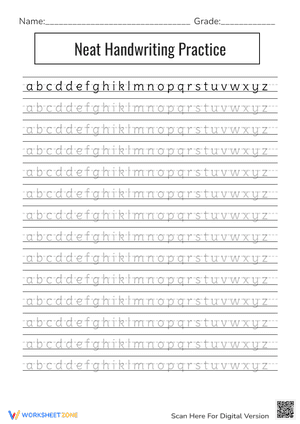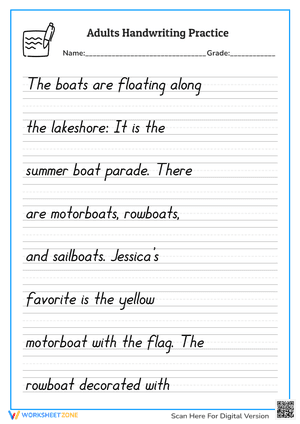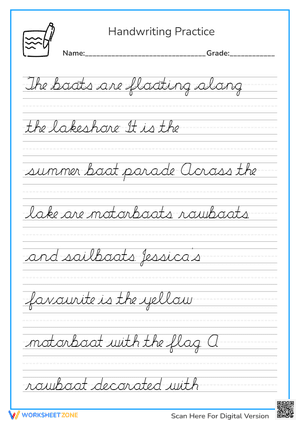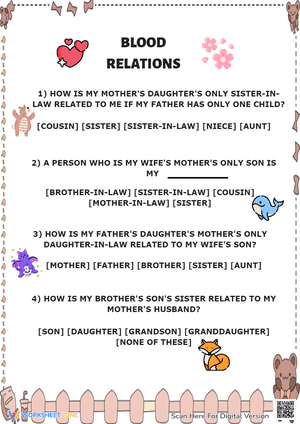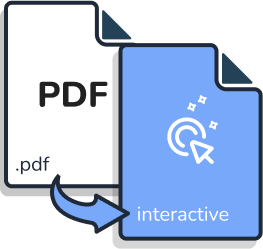What are the primary factors that determine a person's level of fluency in a given language? Some people believe that a linguist expert is someone who can write in a way that is both logical and attractive, while others believe that a brilliant orator is more likely to be a linguist expert.
It's possible that this is why oral and written communication drills are such an important element from the very beginning of the educational career, and even when people become older. In this article, we will cover handwriting practice sheets for adults as well as their benefits and ways to improve. Let's get started!
What are Handwriting Practice Sheets for Adults?
Handwriting practice sheets for adults is a method to help individuals never struggle with finding the right words to put down on paper when they are trying to convey their ideas.
Reading, writing, listening, and speaking are the four abilities that contribute to a person's overall level of linguistic fluency. Because of the prevalence of computers and keyboards in today's environment, handwriting has fallen to a far lower priority than other language skills. On the other hand, if you take a closer look, you'll see that writing with one's hands on a piece of paper is more than simply a means of expression. In point of fact, it is an endeavor that provides several advantages, such as the following:
- Improves one's fine motor skills
- Enhances hand-eye coordination and dexterity
- Adds a degree of consistency to the style of thinking as well as the way that concepts are presented.
- Provides an alternate method of communication for those who struggle with their ability to express themselves verbally.
This is why handwriting practice for adults can be considered a method to evaluate a person’s fluency in a language.
Why are Handwriting Practice Sheets for Adults Important?
You may recall practicing your handwriting as a child by sitting down with a notepad and repeatedly concentrating on improving the curves and lines of each letter. Today, it's possible that you don't utilize your handwriting very much.
Even if the days of practicing cursive by sitting down with a notepad are long gone, you may be shocked to hear that learning to write by hand has a lot of advantages. Here are three justifications for picking up a pen and honing this ability.
Aid with memory retention
When writing by hand as opposed to typing on a computer, both 12-year-olds and young adults learn more effectively and remember knowledge better, according to 2020 research from the Norwegian University of Science and Technology. According to Audrey van der Meer, the senior author of the research, "usage of pen and paper offers the brain additional 'hooks' to hang your memories on."
Boost reading and spelling skills
Reading and spelling abilities in adults may be improved by practicing handwriting, according to a recent John Hopkins University study. In the research, the Arabic alphabet was taught to 42 non-Arabic-speaking people in three groups: hand-writers, typers, and video viewers. Just after two sessions, those in the pen and paper handwriting group started to improve.
Boosts creativity
According to Lloyd, writing down your thoughts might offer your brain the room it needs to become creative. It's one of the key causes of the benefit of doodle breaks at work for creative thinking. The same idea holds true for handwriting. In addition to being a technique of conveying our sentiments and keeping a record of our ideas and feelings, she claims that practicing handwriting also retrains the brain. We can maintain our creativity by creating these new neural pathways.
Nidenoff continues by saying that writing by hand may be a means of expressing one's individuality. According to her, handwriting is unique to a person. When we are younger, we are taught to write like our professors, but as we become older, our writing increasingly takes on its own voice.
Improve your flexibility
First, even when an adult has finished university-level coursework, reading and writing are noticeably sluggish. Second, trouble writing has a neurological basis. Therefore, the purpose of creating these adult handwriting practice sheets is to make use of the brain's neuroplasticity and develop handwriting abilities by mentally engaging the user.
How to Improve Handwriting Practice Sheets for Adults?
Handwriting practice sheets for adults have numerous advantages. It facilitates close verbal interaction even when you're becoming adults. Adults may find it to be a peaceful and reflective experience. Everyone should make an attempt to improve their handwriting. Throughout this post, we'll outline the key techniques for enhancing handwriting.
Part 1: Setting Up For Handwriting
When starting to practice your handwriting, there are numerous factors to be mindful of. Knowing them will enable you to maximize the benefits of your handwriting practice more quickly. They are particularly crucial if you want to teach young children how to write. Their basis and practices for handwriting will improve as a result.
We will go through all the things you need to do to be ready before you begin scribbling in this section on preparation. Your choice of writing instrument(s) and optimum body alignment will be clear. Your hand grip as well as other writing tools that might promote excellent handwriting habits are a few less visible items to pay attention to.
- Choose a Writing Tool
You should choose your writing instrument in this area. A pen or a pencil will it be? You should think about your handwriting skills before choosing a pen or pencil. Do you have a substantial amount of control over your handwriting muscles? If so, you could think of utilizing a pen. In such a case, you could think about utilizing a pencil.
Generally speaking, grownups have well-developed handwriting muscles, so if you'd like to write more smoothly, you should use a pen. However, there is no danger in also writing with a pencil. You may improve your handwriting even more by writing with a pencil.
The ability to control one's handwriting more effectively when utilizing a pencil is its greatest benefit. The less fluid and greater friction motions on the paper contribute to improved handwriting control. Because writing with a pencil causes greater friction at the point, you will be required to apply more pressure to the page. Your handwriting may move more slowly as a result of the extra effort.
You may take the time to focus on your handwriting style by slowing down your writing. For this reason, most young toddlers who start handwriting typically begin with a pencil. We advise letting your young kid write with a pencil initially if you are reading this post to help them with handwriting.
- Choose your hand grip
For writing, there are four different hand grip configurations. The palm, forefinger, and middle finger are used in all hand grips. Some of the hand grips employ the ring finger to grasp the writing instrument. The middle finger is used to hold the writing instrument in the other hand grips.
It's crucial to remember that there's no optimum or proper hand grip while choosing among the four styles to use. To discover the gripper that is most pleasant for you, you will need to experiment with each of the 4 varieties. You will need to make little modifications to your gripper throughout this decision-making process to fit your degree of comfort.
It's acceptable to change your hand grip repeatedly until you discover one that seems natural if you're uncertain of which one makes you feel the most comfortable. The essential takeaway is to try out various hand grips and make adjustments until you reach the level of comfort you want.
If you have been using a certain hand grip since you were a child but suddenly discover that a various hand grip feels more comfortable, it is OK for adults to switch. However, when altering your hand grip as an adult, you may first find it challenging to write well with the new hand grip. When you exercise writing more with your new hand grip, this problem will fade. Like any habit, writing with your new gripper will eventually become second nature to you.
One suggestion is to periodically write using your new hand grip while continuing to use your old gripper for regular writing chores.
- Utilize The Proper Muscle Groups
Many individuals often depend on creating letters with their wrists. The muscles in the forearms are in charge of this. This will eventually put more tension on the forearm, similar to the hand grip.
It is preferable to depend on a bigger muscle group rather than the forearm's tiny muscle group. Many people may be surprised to learn that this bigger muscle group is in charge of the shoulder girdle. This implies that you can move your whole arm by using these bigger muscle groups.
Your handwriting endurance may be increased by using the stronger muscles in your shoulder girdle as you write. When using this muscle group to write, you will experience less weariness.
- Utilize A Slanted Board
Do you know that while writing by hand on a flat surface, you will stoop forward? Many individuals writing by hand on a flat table is a typical sight. To see the paper on a flat table, one must tilt their head forward. It is normal for the body to naturally slouch forward after the head tilts to prevent an excessive head tilt.
The result of writing on a flat surface is that most individuals begin to sit with poor posture. Since we start learning to write at an early age, poor posture persists throughout our formative years. It's crucial to avoid this poor posture from an early age. Similarly, maintaining poor posture as adults is not a smart idea.
Our forefathers have had a fix for the terrible posture brought on by scribbling since the dawn of time. The answer is a straightforward angled table, which was typical of old school desks. However, it has altered in today's society, where flat tables are increasingly typical.
The impracticality of the angled table is most likely the cause of its present lack of popularity. For everyday usage, a flat table is more useful. We can put our things on it without worrying that they may tumble off the table.
Despite this, one cannot overlook the advantage of employing an inclined table. To raise the paper, use an angled table. This reduces the strain on our eyes and makes it easier to read the material. Additionally, it urges us to use less power while placing our writing hand on it. Our writing will be more fluid if we use less effort with our writing hand.
It would be a waste not to write on an inclined table with so many advantages. Fortunately, there is a contemporary substitute for the angled table. A board with an angle is the current substitute. This little board fits on any flat surface and is portable. It has the same ability to improve posture as a specialized angled table.
A specialized angled table is more expensive than a slanted board. Thus, using it while handwriting is a common choice for individuals of all ages.
- Maintain a Good Posture
It is essential that you choose a comfortable position to write in by hand before you even begin. You are going to want to get it correct and eliminate any pain you experience while writing. In addition to this, this will assist you to avoid injuring your body and experiencing aches and pains as a result of poor posture. Handwriting quality may also be improved by maintaining correct posture.
When you are sitting, make sure that both of your feet are firmly planted on the ground. This will help your posture. Your upper body needs to be held in a vertical position.
Lean very little on your writing arm to improve your posture. It is important to remember not to put too much pressure on your writing arm. It is essential that your writing arm have some degree of mobility during the writing process. The purpose of leaning on your writing arm is to give your other arm a chance to relax and rest on the table. You wouldn't want to make yourself tired by elevating your arm when you're writing, would you?
Your other arm will be utilized to move the paper and keep it down as you write with the other arm. Because of this, you shouldn't rely on this arm. While it is pressing down on the paper, you may want to try setting it down on the table.
Part 2: Start Handwriting
Part 2 introduces handwriting instruction and concepts. Each handwriting instruction and tip focuses on a certain component. Part 2 instruction and concepts will maximize your handwriting training.
- Air writing
Write in the air! This exercise engages your whole arm, particularly the shoulder-girdle muscles. It helps you use the right handwriting muscles. This is the greatest activity for a young kid with no handwriting expertise. In air writing, letter forms are formed in the air. Form letter forms using your finger, arm, and shoulder girdle muscles. Start writing a word and then a phrase in the air for a more demanding experience.
Daily air writing helps you activate the right muscle areas. Learning to use more muscle groups can help you widen your handwritten letters. It will be less cramped and more readable.
- Simply Doodle
Doodling is an excellent technique to practice writing. During the activity, practice holding and managing your writing instrument. Doodling also improves your pen control. In "Write in the Air", you studied handwriting without a pen. Doodling helps you control your writing tool. Your handwriting muscles will be taught to make smaller, finer motions than in the last exercise.
As you doodle and grow accustomed to your writing instrument, you gain muscle. Handwriting offers advantages even if you've been doing it for years. Doodling may help you assimilate a new writing skill. This helps you construct handwritten forms.
- Shapes and lines practice
You'll have stronger handwriting muscles after the preceding workouts. You're ready to learn letter mechanics. This is the purpose of fundamental shapes and lines. This activity strengthens handwriting muscles.
You'll work on letter specifics by practicing fundamental shapes and lines. Shapes and lines form a letter. This activity breaks letters into shapes and lines. This simplifies your practice.
Simple shapes and lines simplify letter formation. You may concentrate on drawing letter components effectively. Before handwriting, practice with shapes and lines. The workout warms up handwriting muscles. Warm up before each handwriting session.
- Practice with Handwriting Worksheets for adults
So many tips and training exercises might be daunting. A handwriting notebook may guide practice. A good handwriting workbook will include the aforementioned principles.
- Practice regularly
Last word on handwriting. Practice your penmanship. Handwriting improves with practice.
Schedule weekly handwriting practice. Setting a weekly timetable might help you develop a handwriting habit. If scheduling weekly handwriting practice is challenging, don't worry. Find leisure time to practice penmanship. Or use handwriting as a writing warm-up. It may excite your thoughts and provide handwriting practice.
Part 3: Handwriting On-The-Go
This portion of important strategies to improve handwriting focuses on crucial handwriting characteristics. These factors may enhance your handwriting. While with any talent, you must concentrate on each handwriting step as you write. So, you can fix, enhance, or keep excellent handwriting. These are handwriting features you may alter while you write to enhance your handwriting.
- Clarify handwriting
Handwriting helps you communicate on paper. For handwritten communication, write clearly. That involves making each letter shape appropriately so it's easy to read.
Next, write words. Give proper space between words in a sentence. Too little space makes reading difficult. Like making letters, you want a reader to be able to easily identify each word in your phrase. Remember the aforementioned writing tips.
- Adjust your hand grip
The purpose of your hand grip is crucial for comfort and handwriting endurance, as you've read in Part 1 on "hand grip." As you type, you may change the firmness of your hand grip. Keep in mind that you should have a strong grasp of your writing instrument.
The majority of individuals prefer to tighten their hand grip as they type lengthier sentences. When writing for a longer period of time, you may need to remind yourself to loosen up your grip.
- Change up your writing speed
To increase the quality and control of your handwriting, try writing at different speeds. You may take the time to fully outline each letter's form by writing more slowly. It's entertaining to experiment with writing more quickly as a kind of self-control.
It may encourage better handwriting muscle memory if you practice writing quickly and slowly at various times. This is possible because the different writing speeds will make handwriting more difficult for you, which will help you absorb the skill better.
Part 4: Analysis and Correction of Handwriting
You will learn to examine your handwriting in more detail than in part three of this section. You may identify opportunities for development by looking more closely at your handwriting. Your handwriting will become better if you make the necessary modifications.
Examine Your Writing
You should aim to accomplish the following three things while studying your handwriting:
- Clarity - This refers to how simple it is to read the written text.
- Uniformity – Maintaining consistency in your handwriting's letter forms and word space is known as uniformity.
- Looks good – This indicates that it is easy to read your handwriting.
Consider the three objectives listed above when you examine your handwriting at each stage.
You should make sure that each word is clearly spaced out at the sentence level. Imagine that you can fit the letter "O" in-between each word as a nice trick. Your handwriting will be less clear if the words are written too closely together since they will be crowded and challenging to read. Additionally, you should make sure that your handwritten words are of the same size at the sentence level. Your handwritten phrase will remain consistent and presentable if you do this.
You should think about the slant and placement of your words at the word level. To avoid creating your handwriting less legible and harder to read, try not to tilt your letters too much to the left or right. Some individuals find it more comfortable to write their letters slanted, thus they choose to do so. Keep the tilt moderate in this instance. As usual, it's crucial to make your handwriting consistent. If your letters are slanted, you should work to maintain a consistent slant.
Check to see whether your handwriting is inclined upwards or downwards in the printed word. Alignment is what we call this. Maintaining consistent letter alignment throughout your handwriting is crucial in this situation. If you are having trouble keeping your handwriting evenly spaced, word analysis will provide you with some guidance.
Part 5: Practice Makes Perfect
The last component of mastering handwriting will be the emphasis of this section on the crucial techniques. To practice making your handwriting as flawless as you desire, do this last task. Although this concept may seem straightforward to some, most individuals will find it difficult when trying to improve their handwriting. To easily do this task, you can use our handwriting worksheets to improve your skills.
You're likely to feel motivated after perusing this handwriting instruction manual. This excitement will soon wane, however. Therefore, it is as crucial to developing the mental framework necessary to support your handwriting development journey as it is to understand the technical ways of doing so.
Adult Handwriting Practice Now!
Handwriting practice is good, but where to find a proper hand high-quality source of sheets and instructions for handwriting? In the digital age, it's possible for you to find a wide range of sites and sources that can satisfy your demand for handwriting, but our website worksheetzone.org will bring you an extraordinary experience. Not only do we provide you with numerous adult handwriting practice sheet samples, but we also help you to optimize the time for this process and provide endless handwriting inspiration.
Handwriting practice sheets for adults is a good method to evaluate a person’s fluency in a language. We hope that this instruction above can be beneficial for you in improving your handwriting. Don’t forget to click on our website for a satisfying handwriting experience.
